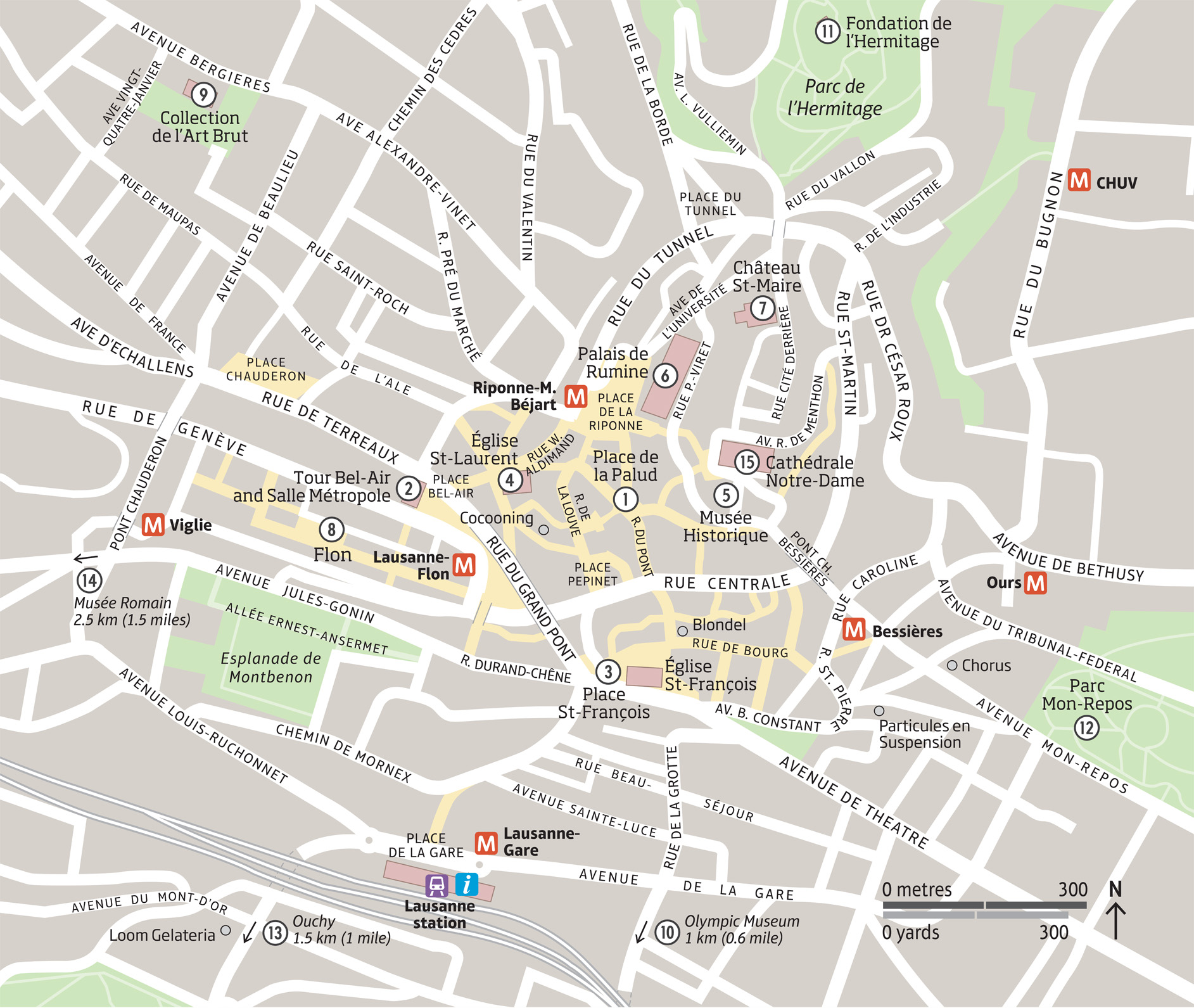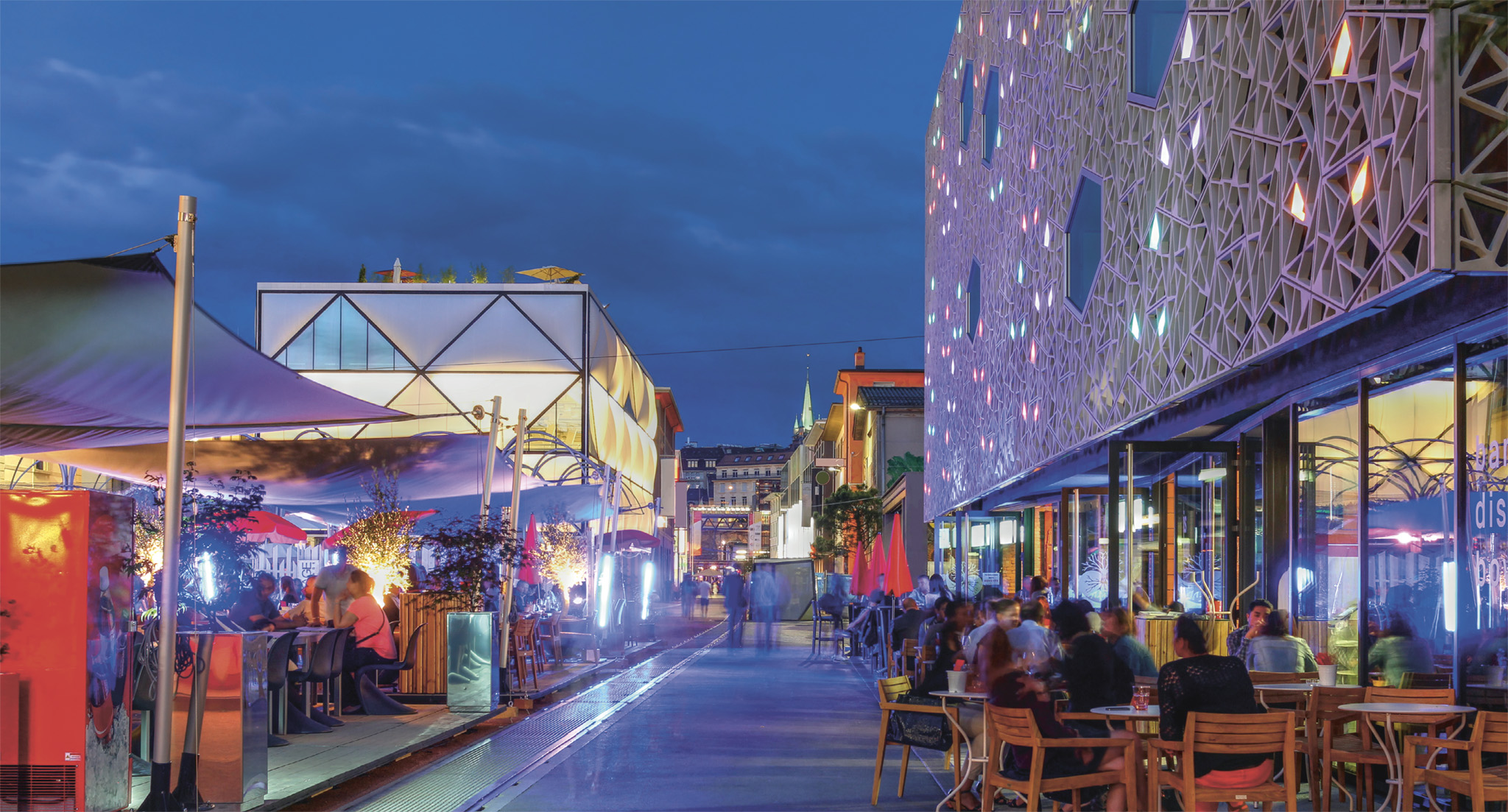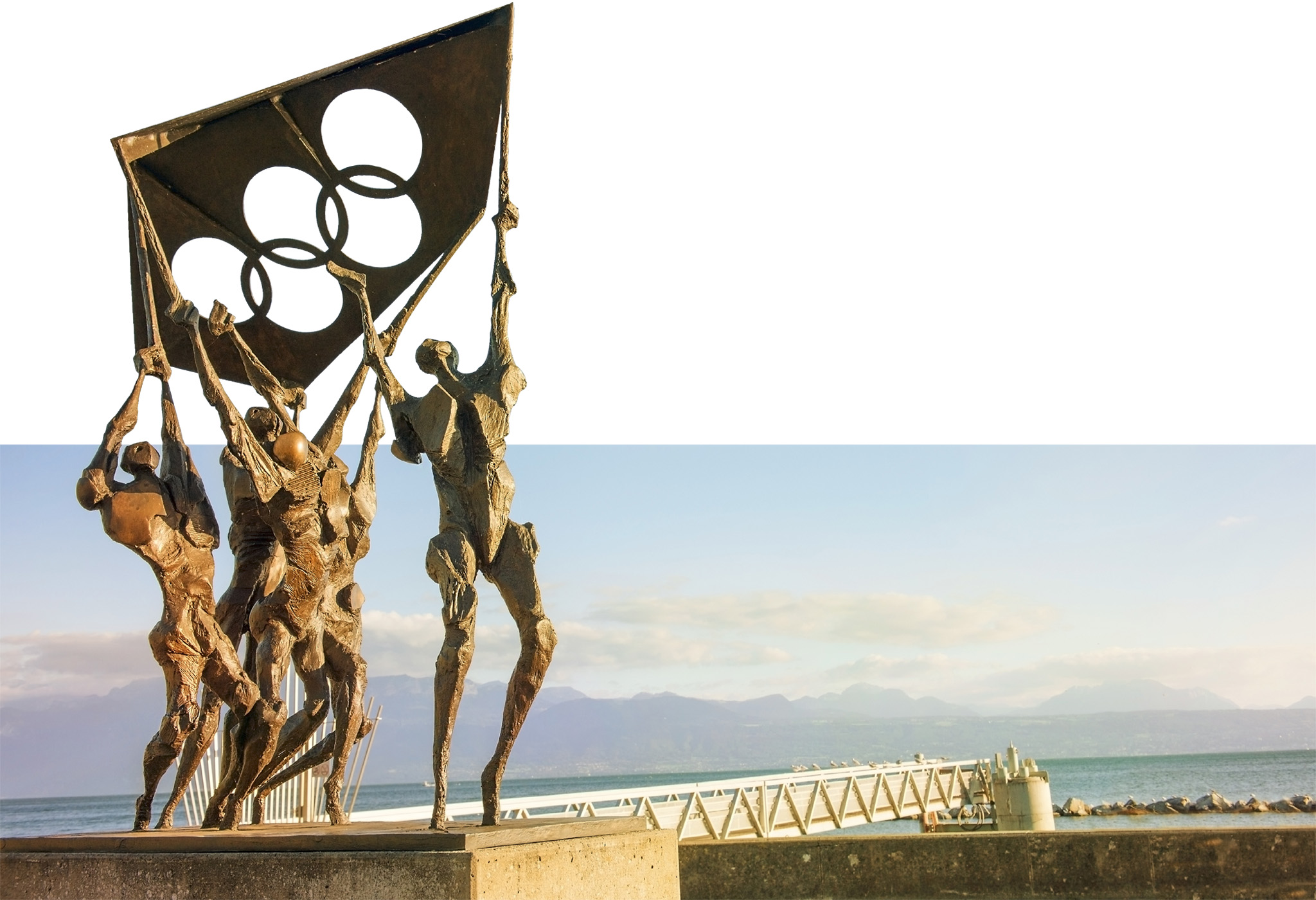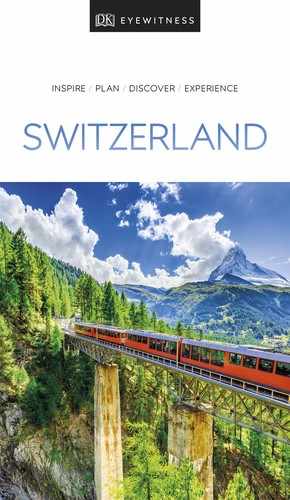B4 ⌂ 200 km (124 miles) SW of Zürich n 9 Place de la Gare; 4 Place de la Navigation; www.lausanne-tourisme.ch
Nestled within the outstandingly beautiful the north shore of Lake Geneva, Lausanne is one of Switzerland’s finest cities. A Roman lakeshore settlement in the 1st century, its inhabitants later moved to higher ground. This area is now the city’s Old Town. Lausanne became a bishopric in the late 6th century, and its Fondation Académie was founded here in 1537. Today the city remains a centre of the cultural and economic life of French-speaking Switzerland. Its importance is evident – it is the location of the Federal Supreme Court and the International Olympic Committee.

t The terracotta-coloured rooftops of Lausanne’s hilltop Old Town
Experience Geneva

n Double-tap image to read the labels
Experience Geneva

t The figure of Justice crowning the 16th-century Fontaine de la Justice
Lausanne’s 17th-century town hall, a grand two-storey arcaded building fronted by the arms of the city, dominates the south side of this market square. On 10 April 1915, the founder of the modern Olympics, Pierre de Coubertin, ratified the establishment of the International Olympic Committee here and moved the headquarters to the city.
At the centre of the square is the 16th-century Fontaine de la Justice, with a figure of Justice. The covered wooden stairs beyond, known as the Escaliers du Marché, lead to Rue Viret, from where further steps lead up to the cathedral.
The square is a popular meeting area. A street market takes place here twice a week on Wednesday and Saturday, and once a month the square is filled with a crafts fair.
1922
The year T S Eliot completed the poem The Wasteland, while under psychiatric care in Lausanne.
Set on a steep slope, at the foot of the Old Town, the Tour Bel-Air was Switzerland’s first high-rise structure. Standing 50 m (165 ft) high, it contains offices, residential apartments and the Salle Métropole theatre. Completed in 1931, the building was initially considered “an insult to good sense and taste”, but quickly became a beloved landmark. Inspired by the cityscape of New York, the building gives the town’s skyline.
The theatre has become one of the city’s cultural hubs and has hosted some of the best in the performing arts. In its heyday, audiences flocked here to see dancer Josephine Baker and trumpeter Louis Armstrong. These days the Métropole’s programme still features some of the world’s most highly acclaimed talents, among them the Ukrainian Classical Ballet and the musician Alain Chamfort. The Lausanne Symphony Orchestra also makes its home here.

GREAT VIEW
Across the Rooftops
Built on a hill, the lower and higher parts of the city are connected by a series of steps. Take the market stairs up to the cathedral, then climb all the way into the belfry, which is the highest point in the city, to soak up stunning views across the roofs of old Lausanne to the green steeple of St-François church, the lake and the mountains beyond.
At the centre of this square stands the Église St-François, built in the 13th and 14th centuries as the church of a Franciscan monastery. The monastery was dissolved during the Reformation and the church stripped of its decoration. A 1990s restoration lifted the façade but the interior is disappointingly bland. The streets leading off Place St-François are among the city’s smartest. Rue du Bourg, which is lined with old houses, contains swanky jewellers’ shops and bijou boutiques, as well as bars and jazz clubs.
Amid the well-preserved houses of the Old Town stands the Protestant Église St-Laurent. Completed in 1719, on the ruins of a 10th-century church, its façade was added in the latter half of the century. Free choral concerts, with an aperitif, are offered throughout the year.

Insider Tip
Jazz Nights
You can catch the latest young talents from Lausanne’s renowned jazz school performing at various venues across the city. Chorus, an atmospheric cellar near the city centre (www.chorus.ch), is one of our favourites. Some gigs are free.
Lausanne’s museum of history fills the restored rooms of the former bishop’s palace, which dates from the 11th century. The museum’s collections provide a detailed account of the city’s history from its inhabitation by Celtic tribes to the present day. Don't miss the fascinating model of Lausanne as it was in 1638.
Built in 1896–1906, the imposing Neo-Renaissance Palais de Rumine was once home to the University of Lausanne. It now contains several museums covering archaeology and history, fine art, geology, zoology and numismatics (the study of currency) – all with the same hours and a shared admission fee. Of particular interest is the Musée Cantonal des Beaux-Arts, on the ground floor, which has a fine collection of Swiss paintings from the 18th to the 20th centuries. The museum of history and archaeology, on the sixth floor, displays a large number of artifacts unearthed in local excavations. The exhibits range from the Bronze Age to the medieval period, and one of the finest is a gold bust of Marcus Aurelius, discovered at Avenches in 1939.
Although it is closed to visitors, you should still seek out this former bishop’s palace. The massive brick and sandstone edifice was built in 1397–1427 for the bishops of Lausanne, who ruled the city. When they were overthrown by Bernese forces, the château became the residence of new overlords, the bailiffs of Bern. The fight for the independence of Lausanne and the canton of Vaud was led by the notary turned soldier Jean Davel, who was beheaded in 1723 on the orders of the Bernese authorities after he led an abortive separatist movement. A monument to his memory stands in front of the château. The building is now the seat of the cantonal authorities of Vaud.

t The streets of the popular Flon district pulsing with energy after dark
Once the main industrial district of Lausanne, Flon was built on a river of the same name that was filled over in the 19th century. If you look down, you can still see water running in a narrow channel under the pavement. These days the area has thrown off its grubby industrial past to become a buzzy entertainment district, its former warehouses converted into shops, bars, restaurants, galleries, a cinema complex and the buzzing MAD nightclub. The main pedestrian square hosts a jungle-themed pop-up bar in summer and an ice rink in winter.
experience Western Switzerland
|
shop Blondel An institution since 1850, Blondel’s sumptuous window displays and the delectable whiff of chocolate wafting out the door make it impossible to pass by this shop without going in. ⌂ Rue de Bourg 5 ∑ blondel.ch Cocooning Pick up soaps, creams and other cosmetics here. They are handmade using natural ingredients – you can pick up a body butter made with the Swiss national flower – edelweiss – for instance. ⌂ Rue Grand-Saint-Jean 16 ∑ cocooning.ch |
Art Brut (“Raw Art”) is the name that the French painter Jean Dubuffet (1901–85) gave to art created by people living on the fringe of society, such as criminals, patients at psychiatric hospitals or institutions, and spiritualist mediums, who had no artistic training. The ideas behind their art were free from established cultural influences and the history of a fine arts tradition. In 1945 Dubuffet began to amass a private collection, which he presented to the city of Lausanne in 1971. The Collection de l’Art Brut opened in 1976.
The exhibits are laid out over four floors in converted stables at the 18th-century Château de Beaulieu, northwest of the city centre. These extraordinary works have a striking force and spontaneity. Alongside each exhibit is a short biography of the artist, providing insights into the circumstances in which these works were created.
Experience Western Switzerland
|
eat Loom Gelateria Join the queue out the door to sample delicious artisanal ice cream. Among the more adventurous offerings here are lapsang-souchong sorbet and curry ice cream. ⌂ Boulevard de Grancy 45 ∑ loom-gelateria.ch |

t Run Up by Nag Arnoldi at the Olympic Museum, overlooking Lake Geneva
Set in peaceful parkland planted with Mediterranean trees and shrubs, the well-presented Olympic Museum illustrates the fascinating history of the Olympic movement. Everything from the athletes of Ancient Greece to the Olympic Games of today is explored via interactive stations, photographs, videos, archive film footage and multimedia presentations. With its excellent facilities for school groups, the museum draws over 200,000 visitors a year. There are many displays specifically geared towards younger visitors, such as “All Different, All Winners” where games investigate themes such as fair play and diversity.
The imposing Neo-Gothic villa set in magnificent grounds north of Lausanne was built in 1842–50 by Charles-Juste Bugnion, a wealthy banker, and donated to the city by his descendants. Now known as the Fondation de l’Hermitage, it is a gallery with an impressive collection of Impressionist and Post-Impressionist paintings, as well as the works of Vaudois artists from the 20th century. Every year the Fondation also stages two or three large-scale temporary exhibitions.
The Parc de l’Hermitage, the extensive grounds in which the villa is set, is landscaped with exotic trees. Towards its northern extremity is the Signal de Sauvabelin, a hill which rises to a height of 647 m (2,120 ft) and offers views of Lake Geneva and the Alps..
Beyond the hill are woodland and the Lac de Sauvabelin, where there is a reserve for ibexes, marmots and other alpine animals.
This landscaped park is the most elegant of all the city’s gardens. At its centre is a Neo-Classical villa, once inhabited by the 18th-century French writer Voltaire. The villa was later home to the Olympics revivalist Baron Pierre de Coubertin (1863–1937), who believed that sport plays an essential role in the development of citizens and nations. In 1894, he established the International Olympic Committee (IOC), and two years later the first modern Olympic Games were held in Athens. Until the 1970s this was also the IOC’s headquarters. At the north end of the park stands Switzerland’s supreme court buildings.

Insider Tip
Lakeside Pop-ups
All throughout the summer, lively pop-up bars and restaurants take over the lakeshore. Join the locals by taking a dip in the lake followed by an apéro and some tasty nibbles at Jetée de la Compagnie (www.jeteedelacompagnie.ch).

t Boats and pedalos in the harbour of Ouchy, a former fishing village
Once a fishing village, Ouchy is now a popular lakeside suburb of Lausanne. It has a beautiful setting on Lake Geneva, with views of the surrounding mountains, and a tree-lined lakeshore promenade. Cruises on the lake depart from here.
A tower is all that remains of the 12th-century castle that once defended the harbour. It forms part of the Neo-Gothic Château d’Ouchy, which was built in the 1890s. The château is now a hotel and restaurant. A short walk along the lakeshore will take you to the Hôtel d’Angleterre. This is the house where Lord Byron stayed during his visit to Lausanne and where he wrote The Prisoner of Chillon, a poem which details the imprisonment of a Genevois monk, François Bonivard.
About ten minutes’ walk west of Ouchy are the remains of Lousonna and Vidy, two Roman towns that flourished from 15 BC to the 4th century AD. Finds uncovered during an excavation here, including glassware and fine mosaics, are on show in the Musée Romain nearby.
